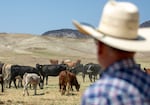
Firefighting equipment hangs above a "Volunteers Needed" sign at Payton Station, headquarters of the Baker Rural Fire Protection District, Baker City, Ore., August 1, 2024. Baker Rural Fire Protection District is a volunteer department that sent crews to the Durkee, Thompson, and other local fires throughout July.
Anna Lueck / OPB
At a Thursday board retreat in Pendleton, officials from the Oregon Department of Forestry went over the grim statistics that have come to define modern fire seasons: In 2024, fires burned more than 1.93 million acres in the state, 18 times the amount compared to 2023.
Department staff also highlighted the ripple effects that go beyond acres burned and firefighting costs.
Joe Hessel, an ODF incident commander and former district forester for northeast Oregon, said the department normally relies on landowners like Eastern Oregon ranchers and farmers to share knowledge of their land with firefighters. While that relationship persisted, Hessel said there was a growing sense of dissatisfaction among some landowners over how the department responded to the fires this year.
Landowners peppered officials throughout the season with questions about the number of personnel the department sent, the equipment they used, the length of time they spent fighting the fire and their overall approach, Hessel said.
“Landowners didn’t want to hear about all the other fires, the lack of resources, or anything else that could be viewed as an excuse for what they viewed as a less than full fledged effort to deal with an emergency on their property,” he said.

Lee Wright looks over his cattle, sheltering from the Durkee fire in his feedlot, to the burned hills that once made up his grazing lands near Vale, Ore., July 31, 2024. Wright lost nearly twenty thousand acres of grazing land to the fire-- meaning he will likely have to lease other pastures for his herd, or sell those he can't afford to feed.
Anna Lueck / OPB
The rising fire protection rates landowners are paying to the state add to the tension.
“It’s sort of a perfect storm for frustration to boil over,” he said. “I believe higher than desired rates have created tension between ODF and landowners at a level that didn’t used to be there, and that the partnership we relied on for years is under significant stress.”
Hessel said the main obstacle is that the system is overloaded. The size and intensity of the fires this year didn’t match the resources the department and its partners had on the ground.
Eastern Oregon ranchers were hit hard by fires almost immediately. The Durkee Fire, which burned nearly 300,000 acres in Baker and Malheur counties – destroyed wide swaths of rangeland. Local farmers said they considered selling some of the cattle that weren’t killed by the fire because they might not be able to feed them anymore.
While the department will continue to fight fires each summer, the board didn’t have any easy answers for a long-term solution.
Board member Brenda McComb, a retired forest science professor, asked if officials should revisit the state’s fire suppression laws to focus more on fires threatening human life and property rather than trying to put out every wildfire.
“My question wasn’t looking for the financial fix, but rather the financial balance,” she said. “Can we spend less money with the military approach to putting out fires and divert that money to post-fire recovery?”
It was a suggestion that wasn’t fully embraced by other board members and department staffers. State forester Cal Mukumoto referenced a cattle pasture the board visited the day before.
“That’s someone’s life. That’s someone’s livestock. That’s what we’re talking about here. People live in and are part of this community and have generations here that have this culture,” he said. “We’re told to go out there, suppress those fires, and that’s what we’ll do.”
Mukumoto said firefighting policy would have to be left to the Legislature. At least one legislator was listening: state Sen. Jeff Golden, D-Ashland, who was in the audience. Last session, Golden co-sponsored a bill that proposed a ballot measure that would have taxed timber companies to help pay for wildfire costs. It died after receiving a committee hearing.



